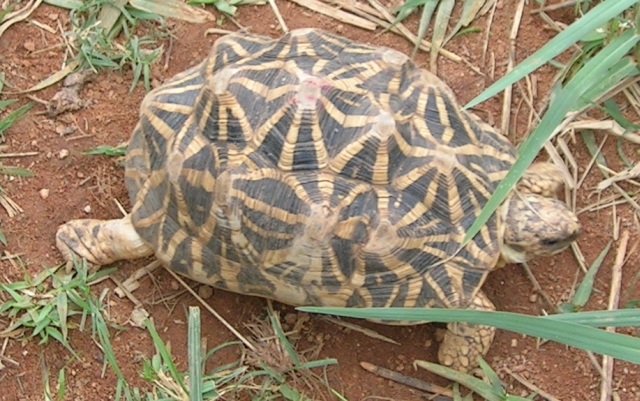- Indian Star Tortoise
Taxobox
name = Indian Star Tortoise
status = LR/lc | status_system = IUCN2.3


image2_caption = Tortoise at theHouston Zoo
regnum =Animal ia
phylum =Chordata
classis = Sauropsida
ordo =Testudines
subordo =Cryptodira
superfamilia =Testudinoidea
familia =Testudinidae
genus = "Geochelone "
species = "G. elegans"
binomial = "Geochelone elegans"
binomial_authority = Schoepf,1795 The Indian Star Tortoise ("Geochelone elegans") is a
species oftortoise found in dry areas and scrub forest inIndia andSri Lanka . This species is quite popular in the exoticpet trade.Description
Carapace very convex, dorsal shields often forming humps; lateral margins nearly vertical; posterior margin somewhat expanded and strongly serrated; no nuchal; supracaudal undivided, incurved in the male; shields strongly striated concentrically; first vertebral longer than broad, the others broader than long, third at least as broad as the corresponding costal.Plastron large, truncated or openly notched in front, deeply notched, bifid behind; suture between the humerals much longer than that between the femorals; suture between the pectorals very short; axillary and inguinal rather small. Head moderate; forehead swollen, convex, and covered with rather small and irregular shields; beak feebly hooked, bi- or tricuspid; edge of jaws denticulated; alveolar ridge of upper jaw strong. Outer-anterior face of fore limb with numerous unequal-sized, large, imbricate, bony, pointed tubercles; heel with large, more or less spur-like tubercles; a group of large conical or subconical tubercles on the hinder side of the thigh. Carapace black, with yellow areolae from which yellow streaks radiate; these streaks usually narrow and very numerous: plastron likewise with black and yellow radiating streaks. The Indian Star Tortoise can grow 10 inches long. [Boulenger, G.A.(1890) Fauna of British India. Reptilia and Batrachia.]The patterning although highly contrasting is disruptive and breaks the outline of the tortoise as it sits in the shade of grass or vegetation. They are mostly herbivorous and feed on
grass es, fallenfruit ,flower s and leaves of succulent plants, and will occasionally eatcarrion .The
sexual dimorphism of adult Indian Star Tortoises is quite apparent. Females are considerably larger than their male counterparts. In addition, the femalesplastron is much flatter than that of the males which has a concave shape.Distribution
India (except Lower Bengal), extending west to Sind: and Ceylon.
Captivity and trade
Raising these animals in captivity is extremely difficult and should be left to those with advanced tortoise experience. They are very finicky eaters and gain weight extremely slowly. Hatchlings would rather sleep than eat and most succomb in the first months of life. A typical hatchling in the
United States costs about $500 from a reputable dealer and you should be prepared to lose this investment if you do not have significant experience with tortoises. It is best to have a close relationship with aveterinarian who has experience with tortoise care.A large number of specimens of this species are found in the illegal wildlife trade in India. Few studies exist which have quantified wild populations and the effect of trade on them.
Curious Feature
The shape of this creature is presumed to be specially adapted to naturally assist it to return to a stable stance after it has been turned over. Mathematicians Gábor Domokos of the
Budapest University of Technology and Economics and Péter Várkonyi ofPrinceton University designed a homogenous object calledGömböc that has exactly one unstable balance point and exactly one stable balance point. Just as a bottom-weighted (non-homogenous weight distribution) sphere would always return to the same upright position, they found it was possible to construct a shape that behaves the same way. After that, they noted the similarity to the Indian Star Turtle and subsequently tested 30 turtles by turning them upside down. They found that many of them were self-righting.References
*
External links
* [http://www.popularpets.net/turtles.php Captive Turtles Information]
* [http://www.reptilesweb.com/reptiles-section/tortoise-world/indian-star-tortoise.html Indian Star Tortoise]
* [http://blog.sciencenews.org/mathtrek/2007/04/cant_knock_it_down.html Self-righting objects]
* [http://www.popularpets.net/turtles/care-sheets/star-tortoise.php Star Tortoise care sheet]
Wikimedia Foundation. 2010.
